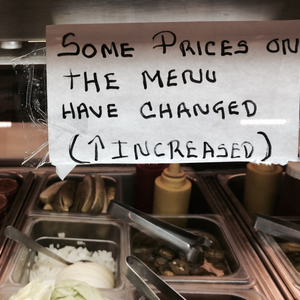When economists track the performance of the U.S. economy, they pay attention to factors like economic growth, inflation, and unemployment. One economic model, the Phillips Curve, suggests that when unemployment is low, inflation increases, and vice-versa. But is that always true? Listen to learn about the relationship between unemployment and inflation, and about how economists’ interventions can actually change it.
Listen to the story
DAVID GREENE: Three of the most important economists in this country sat down for a panel at an economic conference in Atlanta last week. Former Fed chairs Ben Bernanke and Janet Yellen, along with the current Fed chair, Jay Powell, were talking shop and also talking about the latest jobs report. But as Cardiff Garcia and Stacey Vanek Smith from our Planet Money podcast, the Indicator, tell us, a stellar jobs report is not always a good thing.
CARDIFF GARCIA: It was a pretty stellar report – 312,000 jobs added in December, strong wage growth and, of course, unemployment is still below 4 percent. And then here’s Jay Powell’s response.
JAY POWELL: That’s quite welcome and also, for me at this time, does not raise concerns about too high inflation.
STACEY VANEK SMITH: Does not raise concerns about too high inflation. That seems like a weird comment to make, right? We added all these jobs, but that doesn’t mean I’m worried about inflation.
GARCIA: Yeah, but economists discuss the relationship between unemployment and inflation all the time. That relationship is sometimes referred to as the Phillips curve. And that’s this idea that if enough people are working, it will cause inflation. The prices of the things that we buy will start going up. And according to the Phillips curve, the reverse is also true. So if unemployment goes up, then inflation should come down because then companies don’t have to raise wages to compete for workers. There’s more workers out there who need a job.
And we got kind of a test of this back in the late ’70s and early ’80s. Inflation seemed to be getting out of control. Prices were rising up and up and up. And to get inflation under control, Paul Volcker – he was the head of the Federal Reserve at the time – raised interest rates all the way to 20 percent. By comparison, by the way, short-term interest rates right now are at 2 percent. But what Volcker did led to a weaker economy, and unemployment went up.
VANEK SMITH: All the way up to 10 percent. Inflation, though, did come down.
GARCIA: And so everybody’s wondering, is Chair Powell going to worry about inflation, and is he then going to keep raising interest rates to prevent inflation from spiking higher?
POWELL: For me, at this time, does not raise concerns about too high inflation.
GARCIA: Chair Powell is saying that even though unemployment is low and wage growth is rising, it doesn’t necessarily mean that higher inflation will follow. So this relationship between inflation and jobs – even though the Phillips curve predicts it, Powell’s not really seeing it.
VANEK SMITH: Yeah, it’s less curvy. So…
UNIDENTIFIED PERSON: Dr. Bernanke, is the Phillips curve dead?
BEN BERNANKE: To use a slang – economic jargon, this is an endogenous phenomenon (laughter).
VANEK SMITH: Endogenous phenomenon. That’s exactly what – I was just thinking that. Basically, what Bernanke’s saying is that the relationship between unemployment and inflation has changed.
GARCIA: People saw that the Federal Reserve would raise interest rates really high if it needed to to bring inflation back down. And ever since then, inflation has stayed low.
VANEK SMITH: And here’s the key. People and companies act accordingly because if they worried that inflation was going to be much higher in the future, they would spend more money now. And companies would raise prices to try to get ahead of the trend, and that would contribute to inflation going higher right now.
GARCIA: But that’s not happening. And what Ben Bernanke is saying is that it’s precisely because of what the Fed did in the past that the link between low unemployment and high inflation is weaker than it used to be.
BERNANKE: And that’s the, quote, “endogenous” reason why the Phillips curve is so flat.
VANEK SMITH: So economists still strongly debate whether the Phillips curve is really dead or just resting. But if it is, then it was possibly killed by the people in this room – people with this job, Fed chair.
GARCIA: In other words, it’s endogenous.
 © 2019 National Public Radio, Inc. Used with the permission of NPR. All rights reserved.
© 2019 National Public Radio, Inc. Used with the permission of NPR. All rights reserved. Vocabulary
- wage growth – workers’ wages adjusted for the rate of inflation; if wages and inflation increase at the same rate, the real wage growth is zero
- unemployment rate – the measure of the percentage of people in the labor force who are willing and able to work but do not have jobs
- inflation – a rise in prices and a fall in purchasing value of money
- Federal Reserve – the central bank of the United States, which manages the economy in an effort to ensure stability of the financial system
- endogenous phenomenon – variable in a statistical model that is affected by its relationship to other variables in the model
Listening Comprehension Questions
- How did Federal Reserve Chairman Powell react to an excellent jobs report? What question did Powell’s response raise?
- What relationship does the Phillips Curve predict?
- What happened in the 1970s that tested the Phillips Curve?
- What does Powell say about the Phillips Curve now?
- Why do experts think the relationship between unemployment and inflation has changed?
Discussion Themes
- Based on what you heard, do you think the Phillips Curve is no longer relevant? Why or why not?
- What does the change in the Phillips Curve’s predictive power suggest about human behavior?
Teacher’s Guide
Activate student knowledge:
Open class by asking students what, if anything, they know about a connection between inflation and unemployment. Explain that economists see a link. When unemployment is low—that is, when most of the people who want jobs have jobs—they expect inflation to go up. The thinking is that when unemployment is low, employers must woo workers by paying them more. That, in turn, makes them charge more for their products, and that’s inflation in action. So when unemployment is low, economists might still be worried, because inflation could become a problem. Ask students to explain in their own words this connection between unemployment and inflation, so that they can get the most out of the story. Explain that the Federal Reserve is the central bank of the United States, which manages the economy in an effort to ensure stability of the financial system.
Introduce the story:
In this audio story, you will learn why a low unemployment rate is not always completely good news for the economy. Listen to hear why something that you would think is positive may not necessarily be so.
Active listening supports:
The Fate of the Phillips Curve organizer will help guide student listening by focusing listeners on specific words, phrases, or information in the story.
The Language Identification organizer allows students to follow along and track important phrases while listening to the story.
Reflect on the story: Take time for student reflection on the audio story and discussion questions to check for understanding. Assure that students understand what the Phillips Curve is and that it no longer seems to hold true. Be sure they understand that “endogenous phenomenon” means that the way people intervened into the relationship between unemployment and inflation in the past actually changed the relationship between these variables today.
Paired Text:
Use the New York Times story “Yes, There Is a Trade-Off Between Inflation and Unemployment” to gain another perspective on the history of the Phillips Curve.


